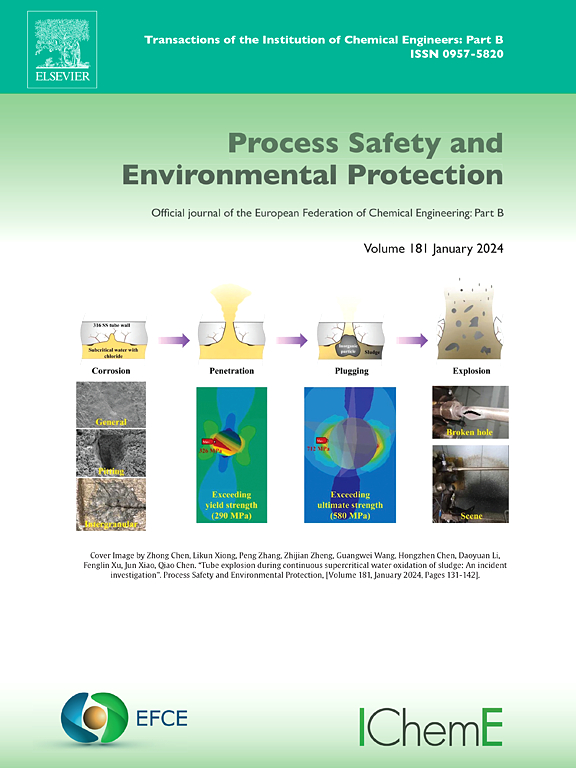航空煤油(RP-3)/乙醇混合燃料热解机理反应分子动力学研究
IF 6.9
2区 环境科学与生态学
Q1 ENGINEERING, CHEMICAL
引用次数: 0
摘要
促进航空燃料的清洁高效燃烧是未来航空发动机技术发展的关键方向。在航空煤油中掺入乙醇是提高燃油燃烧效率、减少污染物排放和降低能源消耗的重要策略。本研究采用反应力场分子动力学(ReaxFF MD)方法模拟分析了不同乙醇掺合比例对RP-3热解过程的影响。通过分析RP-3的初始分解途径、热解产物的演化和分布以及活化能,阐明了乙醇在RP-3燃料分解中的作用。结果表明:低掺比乙醇对RP-3的分解有一定的促进作用,且受温度变化的限制;此外,乙醇可以影响RP-3的初始分解途径。乙醇生成的OH和ch30自由基与RP-3组分相互作用,有利于改善RP-3的热解链式反应。热解动力学分析表明,添加7 wt%和49 wt%的乙醇降低了RP-3的活化能,而添加其他比例的乙醇使RP-3的活化能升高。本研究为了解RP-3/乙醇共混物的热解过程提供了新的视角,为清洁高效航空燃料的开发和应用奠定了基础。本文章由计算机程序翻译,如有差异,请以英文原文为准。
Reactive molecular dynamics study of pyrolysis mechanism of aviation kerosene (RP-3)/ethanol blended fuel
Promoting clean and efficient combustion of aviation fuel is a key direction for the future development of aviation engine technology. Blending ethanol into aviation kerosene is an important strategy to enhance fuel combustion efficiency, reduce pollutant emissions, and mitigate energy consumption. This study employed the reactive force field molecular dynamics (ReaxFF MD) method to simulate and analyze the effects of different ethanol blending ratios on the pyrolysis process of RP-3. By analyzing the initial decomposition pathways of RP-3, the evolution and distribution of pyrolysis products, and the activation energy, the role of ethanol in the decomposition of RP-3 fuel was elucidated. The results show that ethanol with a low blending ratio has a certain promoting effect on the decomposition of RP-3, and this effect is restricted by the change in temperature. Moreover, ethanol can affect the initial decomposition pathway of RP-3. The OH and CH3O radicals generated by ethanol interact with the components of RP-3, which is beneficial for improving the pyrolysis chain reaction of RP-3. The pyrolysis kinetics analysis indicates that the addition of 7 wt% and 49 wt% ethanol reduces the activation energy of RP-3, whereas the addition of other ethanol ratios increases its activation energy. This study provides a new perspective to understand the pyrolysis process of RP-3/ethanol blends and lays the foundation for the development and application of clean and efficient aviation fuels.
求助全文
通过发布文献求助,成功后即可免费获取论文全文。
去求助
来源期刊

Process Safety and Environmental Protection
环境科学-工程:化工
CiteScore
11.40
自引率
15.40%
发文量
929
审稿时长
8.0 months
期刊介绍:
The Process Safety and Environmental Protection (PSEP) journal is a leading international publication that focuses on the publication of high-quality, original research papers in the field of engineering, specifically those related to the safety of industrial processes and environmental protection. The journal encourages submissions that present new developments in safety and environmental aspects, particularly those that show how research findings can be applied in process engineering design and practice.
PSEP is particularly interested in research that brings fresh perspectives to established engineering principles, identifies unsolved problems, or suggests directions for future research. The journal also values contributions that push the boundaries of traditional engineering and welcomes multidisciplinary papers.
PSEP's articles are abstracted and indexed by a range of databases and services, which helps to ensure that the journal's research is accessible and recognized in the academic and professional communities. These databases include ANTE, Chemical Abstracts, Chemical Hazards in Industry, Current Contents, Elsevier Engineering Information database, Pascal Francis, Web of Science, Scopus, Engineering Information Database EnCompass LIT (Elsevier), and INSPEC. This wide coverage facilitates the dissemination of the journal's content to a global audience interested in process safety and environmental engineering.
 求助内容:
求助内容: 应助结果提醒方式:
应助结果提醒方式:


